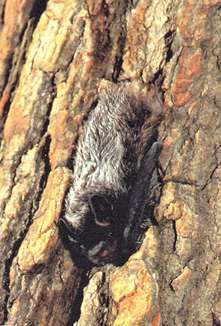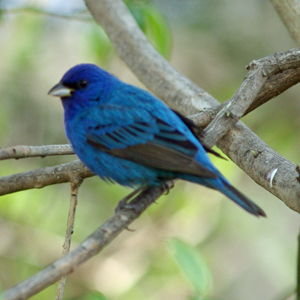Bats of Iowa
Vespertilionidae
Lasionycteris noctivagans (LeConte)
Silver-haired Bat

Etymology
Greek: Lacionycteris -"hairy bal."
Latin: noctivaganss"night wanderer."
Appearance
Fur: Blackish, that on mid-back with silver tipped hairs giving a
frosted appearance;hair-blackish base, silvery tip.
Tail membrane: Blackish; basal one-half furred.
Wing membrane: Blackish, naked. Calcar: Not keeled.
Ears: Short (15 mm), rounded and naked.
Tragus: Less than one-half ear length; blunt tip curved forward.
Total length: 90-115 mm. Forearm: 37-44 mm. Wingspan: 270-310 mm.
Total weight: 8.5-12.5 g.
Dental formula: 36 total; I 2/3, C 1/1, P 2/3, M 3/3.
Confusing Species
Hoary bat (L. cinereus): Larger size (>20 g) and forearm (>46 mm);
whitish hair patches on ears, elbow and wrist; furred dorsal tail
membrane, feet and ears; teeth Incisors 1/3.
Distribution and Status
Overall: Most areas from Alaska and southern Canada to southern
United States.
Iowa: Females found statewide in summer; males known only during
migration.
Natural History
In summer, the silver-haired bat resides in woodlands, often
adjacent to waterways and ponds. Although loose bark and tree
cavities are used as nursery sites, precise summer roosting data are
scarce.
Because of its forest roosting habit, the silver-haired bat is
difficult to see and is rarely encountered by humans. During spring
and fall migration, there is some population build-up as males
moving through the state join females and young of the year.
Migrants arrive in Iowa by early April and leave by early October.
These bats are low, slow fliers that, like most bats in Iowa, have
two activity peaks-early evening and early morning. During foraging,
a variety of insects are captured (including moths, flies, termites,
beetles, caddis flies), suggesting that this species is an
opportunistic feeder.
Although the silver-haired bat probably mates in fall, the sperm
cells are stored by the female until spring. She usually gives birth
to two young in June and July. In Iowa, lactating females have been
reported in late June and flying young by mid-July.
Since females may be found throughout the state in the summer, this
species does not appear to be in immediate danger of decline.
Because it is a forest dweller, continued destruction of wooded
habitat (especially in central and southern Iowa) could have a
detrimental effect upon its survival in the state.

.jpg)
